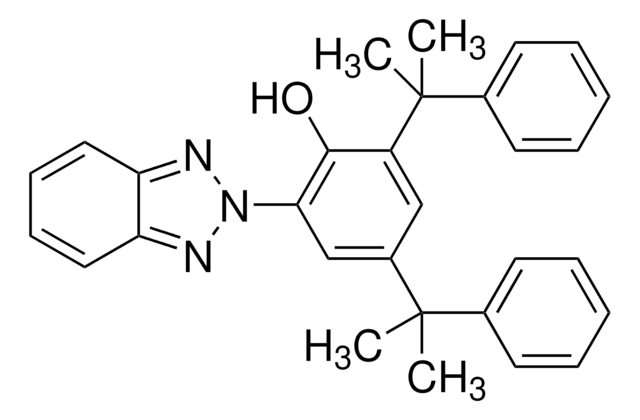535834
Bis(2,2,6,6-tetramethyl-4-piperidyl) sebacate
About This Item
Prodotti consigliati
Perdita
0.7 wt. % volatility, 150-175°C
Punto di fusione
82-85 °C (lit.)
Temp. transizione
Tg >350 °C (dec)
Solubilità
acetone: 19 % (w/w) at 20 °C
ethyl acetate: 24 % (w/w) at 20 °C
methanol: 38 % (w/w) at 20 °C
chloroform: 45 % (w/w) at 20 °C
methylene chloride: 56 % (w/w) at 20 °C
H2O: insoluble <6 ppm at 20 °C
Stringa SMILE
CC1(C)CC(CC(C)(C)N1)OC(=O)CCCCCCCCC(=O)OC2CC(C)(C)NC(C)(C)C2
InChI
1S/C28H52N2O4/c1-25(2)17-21(18-26(3,4)29-25)33-23(31)15-13-11-9-10-12-14-16-24(32)34-22-19-27(5,6)30-28(7,8)20-22/h21-22,29-30H,9-20H2,1-8H3
XITRBUPOXXBIJN-UHFFFAOYSA-N
Cerchi prodotti simili? Visita Guida al confronto tra prodotti
Categorie correlate
Descrizione generale
Applicazioni
Avvertenze
Danger
Indicazioni di pericolo
Consigli di prudenza
Classi di pericolo
Aquatic Acute 1 - Aquatic Chronic 2 - Eye Dam. 1
Codice della classe di stoccaggio
11 - Combustible Solids
Classe di pericolosità dell'acqua (WGK)
WGK 3
Punto d’infiammabilità (°F)
>302.0 °F
Punto d’infiammabilità (°C)
> 150 °C
Dispositivi di protezione individuale
Eyeshields, Faceshields, Gloves, type P2 (EN 143) respirator cartridges
Certificati d'analisi (COA)
Cerca il Certificati d'analisi (COA) digitando il numero di lotto/batch corrispondente. I numeri di lotto o di batch sono stampati sull'etichetta dei prodotti dopo la parola ‘Lotto’ o ‘Batch’.
Possiedi già questo prodotto?
I documenti relativi ai prodotti acquistati recentemente sono disponibili nell’Archivio dei documenti.
I clienti hanno visto anche
Il team dei nostri ricercatori vanta grande esperienza in tutte le aree della ricerca quali Life Science, scienza dei materiali, sintesi chimica, cromatografia, discipline analitiche, ecc..
Contatta l'Assistenza Tecnica.![Poly[[6-[(1,1,3,3-tetramethylbutyl)amino]-s-triazine-2,4-diyl]-[(2,2,6,6-tetramethyl-4-piperidyl)imino]-hexamethylene-[(2,2,6,6-tetramethyl-4-piperidyl)imino] average Mn ~2,000](/deepweb/assets/sigmaaldrich/product/structures/679/088/c718a900-edcf-4dfa-ac1e-c410f3f12ab5/640/c718a900-edcf-4dfa-ac1e-c410f3f12ab5.png)










